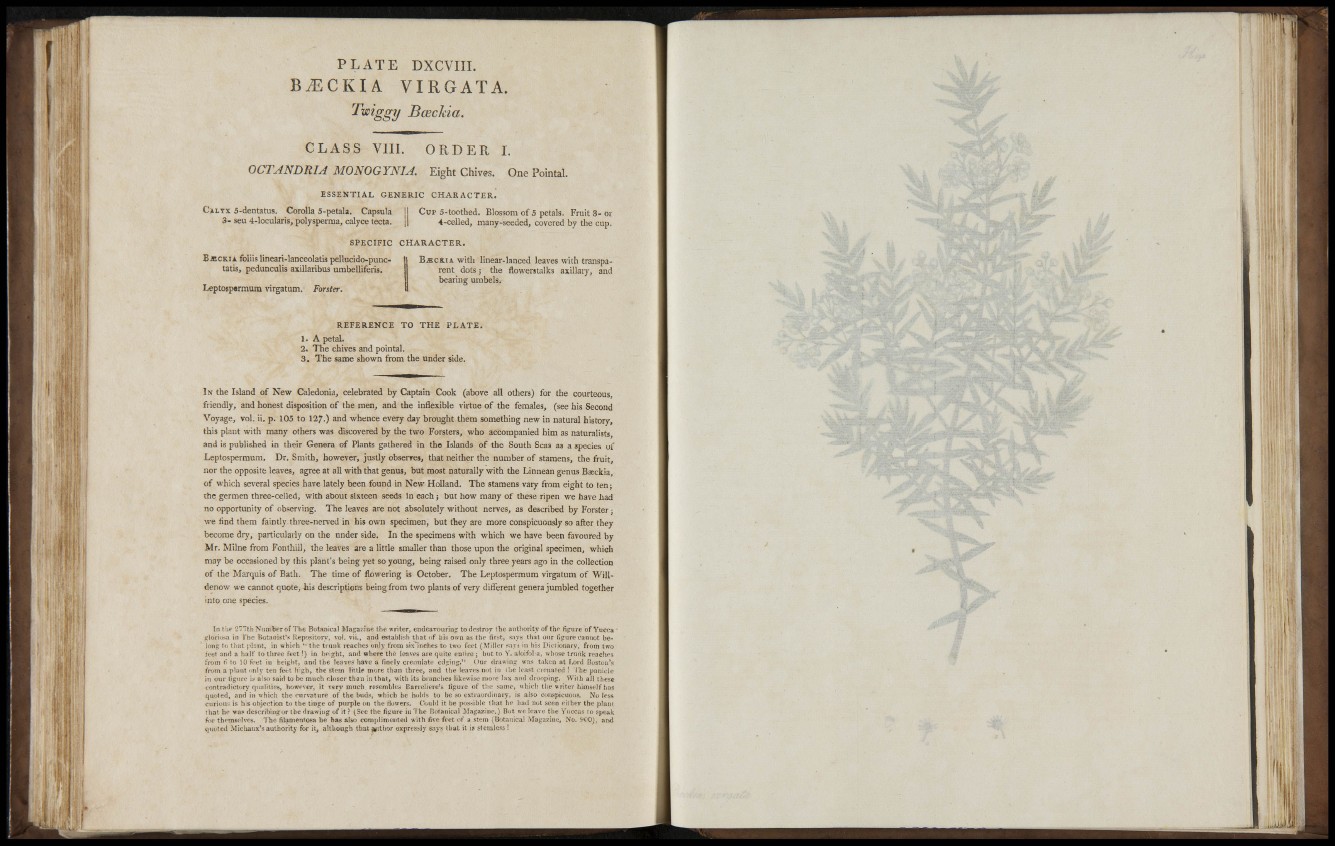
Iff the Island of New Caledonia^ celebrated by Captain Cook (above all otliers) for the courteous,
friendly, and honest disposition of the men, and the inflexible virtue of the females, (see his Second
Voyage, vol. ii. p. 105 to 127.) and whence every day brought them something new in natural history,
this plant with many others was discovered by the two Forsters, who accompanied him as naturalists
and is published in their Genera of Plants gathered in the Islands of the South Seas as a species of
Leptospermum. Dr. Smith, however, justly observes, that neither the number of stamens, the fruit,
nor the opposite leaves, agree at all with that genus, but most naturally with the Linnean genus Baeckia,
of which several species have lately been found in New Holland. The stamens vary from eight to ten;
the germen three-celled, with about sixteen seeds in each ; but how many of these ripen we have had
no opportunity of observing. The leaves are not absolutely without nerves, as described by Forster j
we find them faintly three-nerved in his own specimen, but ttey are more conspicuously so after they
become dry, particularly on the nnder side. In the specimens with which we have been favoured by
Mr. Milne from Fonthill, the leaves are a little smaller than those upon the original specimen, which
may be occasioned by this plant's being yet so young, being raised only three years ago in the collection
of the Marquis of Bath. The time of flowering is October. The Leptospermum virgatum of Willdenow
we cannot quote, his descriptions being from two plants of very different genera jumbled together
into one species.
In the 277th Nnmbpr of The Botanical Magazine the writer, endeaTouring to destroy the antliority of the figure of Yucca
gloriosa in I'he Botanist's Repository, vol. vii., and establish that of his own as the first, says that our figure cannot heioTig
to that plant, in which " the trunk reaches only from six'jnches to two feet (Miller says in his Dictionary, from two
feet and a half to three feet !) in height, and where thè leaves are quite entire i hut to Y. aloifol a, wliose trunk reaches
from Ò to 10 feet in height, and the leaves have a finely creinilate edging." Our drawing was taken at I,ord Bustoii's
from a plant only ten feet high, the stern little more than three, and ttie leav<!S not in ilie least crenated ! The panicle
in our tigure is aiso said to be much closer than in tha t , with its blanches likewise more lax and drooping. Willi all these
contradictor^'qualities, however, it very much resembles Earreliere's ligure of the same, which the riter himself lias
quoted, and in which the curvature of the buds, which he holds to be so extraordinary, is also conspicuous. No less
cnrioas is his objection to the tinge of purple on the dowers. Could it he possible that he had not seen either the plant
t h a t he was describing or the drawing of it ? (See the figure in The Tiotanical Magazine.) Hut we leave the Yuccas to speak
f o r themEclves. 'I'he filamentosa he has also complimented with five feet of a stem (Botanical Magazine, No. o()0), and
quoted Micliaux's authority for it, although that ^ i thor expressly says that it is steinless !
I vi
1 ; I r